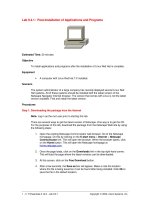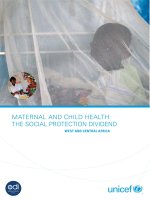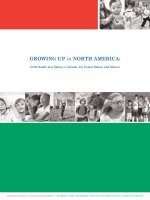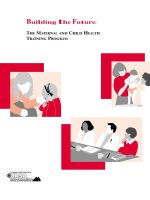Tài liệu INDIAN JOURNAL OF MATERNAL AND CHILD HEALTH potx
Bạn đang xem bản rút gọn của tài liệu. Xem và tải ngay bản đầy đủ của tài liệu tại đây (163.49 KB, 6 trang )
1
Volume 13 (3), 2011
A community based study on menstrual hygiene among
adolescent girls
Keerti Jogdand
Pravin Yerpude
www.ijmch.org
INDIAN JOURNAL OF
MATERNAL AND CHILD
HEALTH
What are menstrual hygiene practices among adolescent girls?
INDIAN JOURNAL OF MATERNAL AND CHILD HEALTH,2011
JUL – SEP;13(3)
2
A community based study on menstrual hygiene among adolescent girls
Keerti Jogdand,* Pravin Yerpude*
*Assistant professor, Dept of Community Medicine, Katuri Medical College and Hospital, Katuri Nagar,
Chinakondrupadu, Guntur (AP).
Correspondence: Dr. Keerti Jogdand,
Email:
ABSTRACT
Research Question
What are menstrual hygiene practices among adolescent girls?
Settings: Urban slum area under urban health training centre of Katuri Medical College and
Hospital, Guntur, Andhra Pradesh.
Study design: A community based cross sectional study
Participants: 360 adolescent girls
Methodology: One slum area out of four selected by simple random sampling and all
adolescent girls in that slum area selected for study
Results: Age of attainment of menarche ranged from eleven to sixteen years. Only 36.19%
girls were aware regarding menstruation prior to the attainment of menarche. Mother was
found to be the first source of information regarding menstruation in 61.29% of girls.
34.63% girls reported use of old cloth for protection during menstruation. 78.99% girls were
restricted to attend religious occasions during menstruation
Key words: Adolescent girls, menstrual hygiene, menstrual practices
INDIAN JOURNAL OF MATERNAL AND CHILD HEALTH,2011
JUL – SEP;13(3)
3
INTRODUCTION
WHO has defined Adolescence as the period between 10-19 years of life.
(1)
Adolescent girls
constitute about 1/5
th
total female population in the world. Adolescence in girls has been
recognized as a special period in their life cycle that requires specific and special attention.
This period is marked with onset of menarche. Menstruation is a phenomenon unique to all
females.
(2)
It is still considered as something unclean or dirty in Indian society.
(3)
This
concept is responsible for related taboos. The first menstruation is often horrifying and
traumatic to an adolescent girl because it usually occurs without her knowing about it.
(4)
Although menstruation is a natural process, it is linked with several perceptions and
practices, which sometimes result in adverse health outcomes. Women having a better
knowledge regarding menstrual hygiene and safe menstrual practices are less vulnerable to
reproductive tract infections and its consequences. So the present study was undertaken to
study knowledge, status of hygiene and practices regarding menstruation among adolescent
girls in an urban slums.
MATERIAL AND METHODS
The Urban health training centre at Guntur is urban field practice area attached to the dept
of Community Medicine, Katuri Medical College and Hospital, Guntur. The field practice area
is divided into 4 slum area out of which one area i.e. Shrinavas Rao Thota was selected by
simple random sampling method. The population of area was approximately 3500. Total 360
adolescent girls were present in the study area. All unmarried, non-pregnant, non-lactating
adolescent girls(10-19 years) with attainment of menarche were included in the
study(n=257). A community based cross-sectional study was carried out from March 2008 to
September 2008. After obtaining informed consent, information regarding menstrual
hygiene was recorded in predesigned pre-tested proforma.
RESULTS
Out of total 360 adolescent girls, 257(71.39 %) girls have attained menarche. Maximum
number of girls (72.77%) have attained menarche in the age ranged between 12-14 years.
15.96% girls have reported blood flow for more than 5 days. In 66.54% girls, menstrual cycle
was of 28-32 days (Table I).
Only 36.19% girls were aware regarding menstruation prior to the attainment of menarche.
In 61.29% of girls mother was found to be first source of information regarding
menstruation. Teachers, friends and relatives were other sources of information (Table II).
53.7% girls have reported use of sanitary pads during menstruation. 34.63% girls have
reported use of old clothes during menstruation (Table III).
78.99% girls were not allowed to attend religious occasions. 22.97% and 20.63% girls
respectively were restricted from doing routine household work and playing (Table IV).
INDIAN JOURNAL OF MATERNAL AND CHILD HEALTH,2011
JUL – SEP;13(3)
4
Table I: Menstrual pattern in adolescent girls (n=257)
Pattern Number (%)
Age at which menarche attained
< 12
12-14
>14
19(7.39)
187(72.77)
51(19.84)
Duration of blood flow in days
< 2
3-5
>5
19(7.39)
197(76.65)
41(15.96)
Length of cycle in days
< 28
28-32
>32
37(14.40)
171(66.54)
49(19.06)
Quantity of blood flow
Normal
Excessive
Scanty
202(78.59)
39(15.18)
16(6.23)
Table II: Awareness regarding menstruation among adolescent girls
Awareness (n=257) Number (%)
Present
Absent
93(36.19)
164(63.81)
Source of information regarding menstruation(n=93)
Mother
Teacher
Friend
Relative
57(61.29)
13(13.98)
21(22.58)
2(2.15)
Table III: Practices of menstrual hygiene among adolescent girls (n=257)
Type of protection used Number (%)
Sanitary pads
Old clothes
Both
138(53.70)
89(34.63)
30(11.67)
INDIAN JOURNAL OF MATERNAL AND CHILD HEALTH,2011
JUL – SEP;13(3)
5
Table IV: Restrictions practiced during menstruation among adolescent girls (n=257)
Restriction practiced for(multiple responses) Number (%)
Religious occasions
Routine household work
Playing
Attending school
Certain types of foods
203(78.99)
59(22.96)
53(20.62)
27(10.51)
9(3.50)
DISCUSSION
In the present study maximum number of girls have attained menarche between 12-14
years. Narayana et al
(5)
reported findings similar to present study. 76.65% girls have
reported blood flow between 3-5 days. Balsubramanian
(6)
reported 84% girls had 3-5 days
menstrual blood flow.
Only 36.19% adolescent girls were aware about menstruation before attainment of
menarche. This may be due to ignorance and low level of education among mothers of
adolescent girls. Similar findings were reported by some authors.
(4,7)
In present study
61.29% girls reported mother as a first source of information. Close relation and better
communication between mother and daughter may be the reason for present study finding.
Singh et al
(8)
found in 64.9% girls mother was first source of information similar to the
present study. 34.63% girls have reported use of old clothes during menstruation. Poverty,
high cost of sanitary pads and ignorance may be the reasons for present finding. Few
authors
(3,7,8)
found ignorance among girls regarding use of sanitary pads during
menstruation similar to present study. A number of studies
(3,4,5,8)
reported different type of
restrictions observed during menstruation similar to present findings.
CONCLUSION
The result of the study revealed that mothers of adolescent girls were ignorant about
informing daughters about menstruation prior to menarche. All mothers irrespective of
their educational status should be taught to break their inhibitions about discussing with
their daughters regarding menstruation before age of menarche. Education regarding
reproductive health and hygiene should be included as a part of school curriculum. Better
hygienic practices can be adopted by making sanitary pads available at affordable prices
(social marketing). Government of India is starting a scheme of making available subsidized
sanitary napkins to adolescent girls in the age group of 10-19 years in rural India from
August 2011. As part of promotion of menstrual hygiene, the napkins will be sold by the
ASHA to girls at a cost of Rs.6 for a pack of six i.e. Rs.1 per piece in the villages.
INDIAN JOURNAL OF MATERNAL AND CHILD HEALTH,2011
JUL – SEP;13(3)
6
REFERENCES
1. World Health Organization. Programming for adolescent health and
development.WHO Technical Report Series No.886,1996:2.
2. Drakshayani DK, Venkata RP. A study on menstrual hygiene among rural adolescent
girls. Ind J Med Sci 1994;48(6):139-43.
3. Dasgupta A, Sarkar M. Menstrual hygiene: How hygienic is adolescent girl? Indian J
Community Med 2008;33(2):77-80.
4. Gupta J, Gupta H. Adolescents and menstruation. The Journal of Family Welfare
2001;47(1):1-12.
5. Narayana KA, Srinivasa DK, Petlo PJ. Puberty rituals, reproductive knowledge and
health of adolescent school girls in south India. Asia Pacific Population Journal
2001;16(2):225-38.
6. Balasubramanian P. Health needs of poor unmarried adolescent girls-A community
based study in rural Tamilnadu. Indian Journal of Population Education 2005;March-
June:18-33.
7. Khanna A, Goyal RS, Bhawsar R. Menstrual practices and reproductive problems: A
study of adolescent girls in Rajasthan. J Health Management 2005;7:91-107.
8. Singh SP, Singh M, Arora M, Sen P. Knowledge assessment regarding puberty and
menstruation among school adolescent girls of district Varanasi. Indian J Preventive
Social Medicine 2006;37(1,2):9-14.









